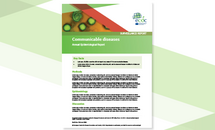Legionnaires' disease - Annual Epidemiological Report for 2021
In 2021, the highest annual notification rate of Legionnaires’ disease to date in the EU/EEA was observed, at 2.4 cases per 100 000 population. The rates are heterogenous across the EU/EEA region, with age-standardised rates varying by country between <1–5 cases per 100 000 population.
Four countries (Italy, France, Spain, and Germany) accounted for 75% of all the notified cases. Males aged 65 years and above were the most affected group (8.9 cases per 100 000 population). Only 11% of the cases were reported as culture-confirmed. This is likely leading to an underestimation of cases of Legionnaires’ disease caused by Legionella species other than Legionella pneumophila. The majority of the cases were considered to be community-acquired.
Occurrence of at least one outbreak of Legionnaires’ disease was reported by eight of the 27 EU/EEA countries reporting data to the outbreak reporting scheme. A total of 19 outbreaks involving 137 confirmed cases were reported.
The travel-associated Legionnaires’ disease (TALD) surveillance scheme observed a 38% increase in cases compared with 2020. Similar to previous years, 90% of the TALD cases occurred in individuals aged 45 years and above. A similar age distribution was observed in the annual retrospective data collection of cases of Legionnaires’ disease.
Download








